After she graduated from the Rhode Island School of Design, Heidi Howard says she went through “that natural artist progression: nomad, waitress, seamstress, hatter, mother—and, ultimately, historic trade- and tavern-sign painter.” She’s moving on in her art now, focusing on paintings and sculpture that continue to be informed by historic objects and material culture. But for 15 years, Howard created trade signs in the style of 18th- and 19th-century sign painters.
The Arah Phelps Inn sign., ca. 1826, by esteemed sign-maker William Rice. Connecticut Historical Society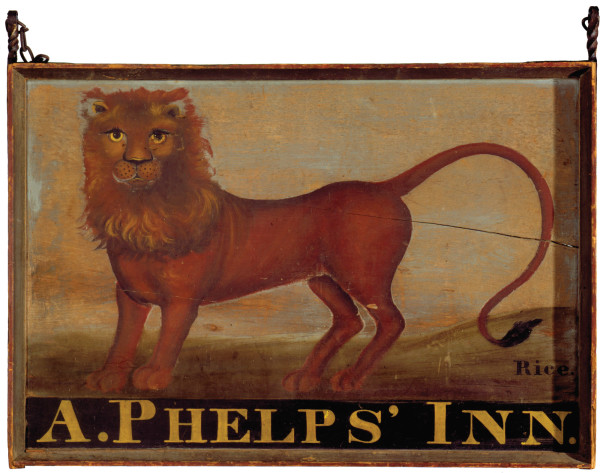
She used salvaged 100- to 200-year-old boards, painted and lettered by hand. “The wood I used has a lot of aging already because it’s so old, but I also used sandpaper or hit it with a hammer or a chain, to make it look older,” she said.
Howard produced both historic-reproduction signs and custom work. “I’d ask clients for their ideas. Sometimes they pulled out a picture of their house; sometimes they’d ask for a sign based on an ancestor’s vocation, or an iconic symbol, or they’d just want a sign with the name of the family homestead or farm.”
“Stiles Tavern” is an imagined sign by Heidi Howard. Morgan B. Brainard Collection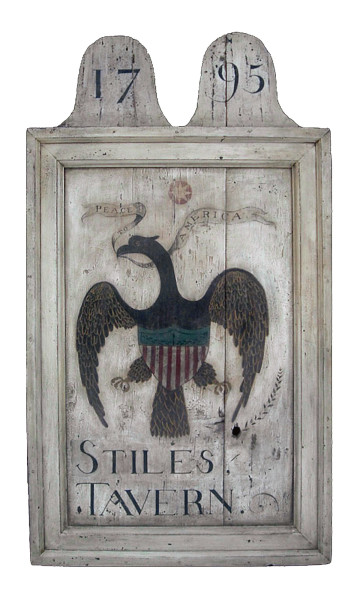
The signs’ boards and mouldings were assembled with antique iron nails. Years ago, Howard was given a giant box of hand-cut nails that had been removed from a house being torn down. The box is almost empty now.
her interest in this particular form of folk art dates to 2003, when Heidi Howard saw an exhibition of tavern signs from the collection of the Connecticut Historical Society. That exhibition, along with a book written to accompany it, continue to be the best source of information about early American trade signs. According to curator and author Susan P. Schoelwer, a “tavern sign” is typically a wooden signboard painted on both sides with a combination of images and words and equipped with often-decorative, forged-iron hanging hardware.
Bissell’s Inn post-and-rail sign, South Windsor, Conn., ca. 1777, woodwork by Eliphalet Chapin. Connecticut Historical Society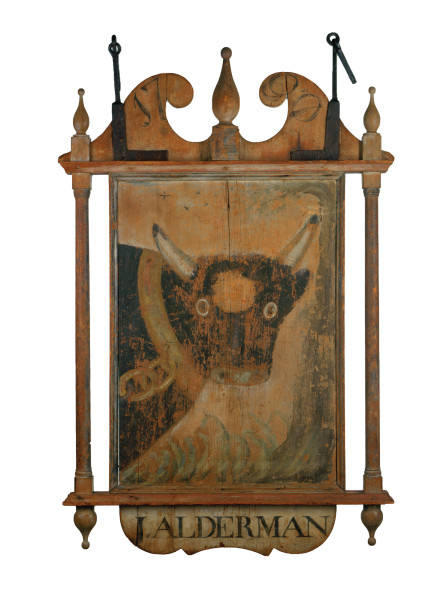
Tavern signs came about as a practical way to identify dwellings licensed to provide food or lodging—i.e., “public houses.” Based on the number of licensed taverns, one estimate is that 5,000 tavern signs were produced in Connecticut between 1750 and 1850. Because they were made of wood and exposed to the elements, only about 100 (2%) are known to have survived; nearly 70 of these survivors are at the Connecticut Historical Society.
“One Eyed Ox” is another original Howard design. The ox in the painting has a leather eye patch. Morgan B. Brainard Collection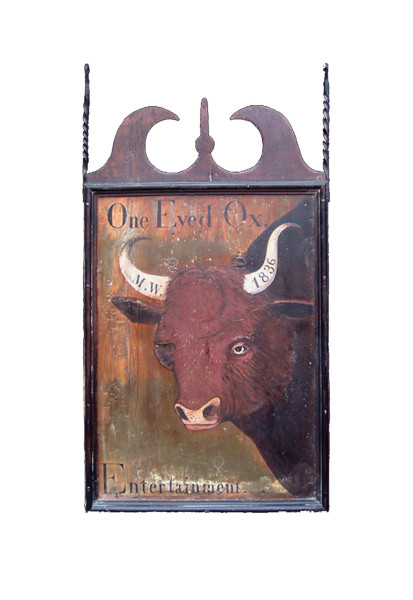
The collection is well documented, thanks to Hartford insurance company president Morgan B. Brainard, who began collecting signs in the 1920s. Given his antiquarian interests, Brainard linked the signs to towns and even to individual owners, through research of tavern licenses, newspaper advertisements, and other primary documents.
Schoelwer points out that tavern and trade (business) signs incorporated three craft traditions: woodworking, painting, and metal-smithing. Surviving signs from the 1700s are characterized by relatively complex, sophisticated woodworking and simple, unsophisticated painting, she says; this corresponds to the profusion of woodworking shops at the time contrasted with a scarcity of trained painters. On the other hand, 19th-century signs tend to have simpler woodworking but more sophisticated imagery. Original hardware often has been lost or replaced.
Although their decorative motifs and styles of imagery are notable themselves, trade signs are not only folk art. They also serve to document the visual language of advertising,
and to offer insight into daily life, travel, and the patriotic sentiments of the time.
Carter’s Inn sign, Clinton, Conn., ca. 1823, attributed to Solomon Jones & Thomas K. Bush. Connecticut Historical Society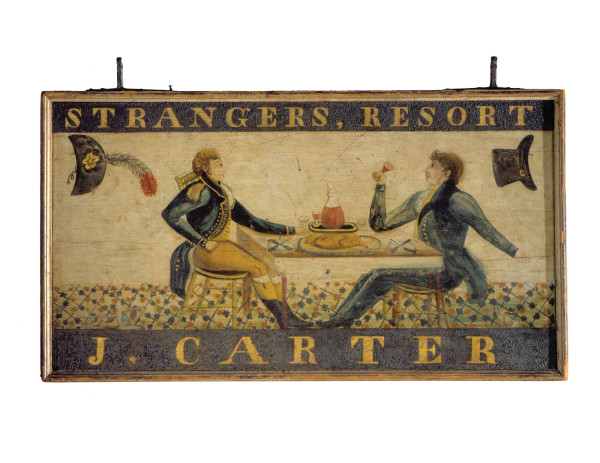
Resources
> Heidi Howard (retired). See works for sale at squareup.com/market/heidi-howard-maker-and-painter
> Phyllis Hawkes Studio Replicas of original signs with attention to shapes and mouldings.
> The 13th Colony Wisconsin-based seller of folk-art signs.
> Vintage Sign Studio Museum-quality reproductions and original design by Peter Koenig; the artist uses new and aged wood (including old shutters, doors, etc.) with techniques developed over time.
> Walker’s Colonial American Sign Company Hand-painted reproduction and custom signs of museum quality; if specified, for exterior use.
> WillIam Meyers Painter & Maker Hand-painted authentic tavern and trade signs on old barnboard.
> Connecticut Historical Society Dating 1749–1892, signs in this collection have hung for over half a century in the museum headquarters on Elizabeth St. in Hartford, Conn. connecticuthistory.org/tavern-signs-mark-changes-in-travel-innkeeping-and-artistic- practice/
> Lions & Eagles & Bulls: Early American Tavern & Inn Signs from the Connecticut Historical Society ed. by Susan P. Schoelwer, 2000. Through amazon.com and antiquarian booksellers. Widely lauded exhibition catalog includes 177 illustrations.







